Public Artworks
The City of Oshawa maintains a collection of public artworks, including murals, sculptures, and monuments. The City also regularly develops and presents temporary artworks in the public sphere.
New Public Art
| Stay True by Jon Colwell |
|
Type: Temporary Mural Location: South Oshawa Community Centre Year: 2024 About the Artwork: Stay True is an autobiographical piece by Jon Colwell, exploring the tension between his creative vision and the expectations imposed on him by others because of his Indigenous identity. Colwell symbolizes himself as the eagle depicted in a neo-traditional tattoo style, venturing into creating new works while the background hints at the Woodland style artwork, typically expected of him, being left behind. The black border and beveled edges represent a still frame or Polaroid, capturing the decisive moment to deviate from expectations and pursue authentic self-representation. |
| One Fish Two Fish by Meaghan Claire Kehoe |
|
Type: Temporary Mural Location: Northview Community Centre Year: 2024 About the Artwork: One Fish Two Fish is an exploration of childhood nostalgia, depicted through vibrant colours and playful forms intended to recall joyful memories. Inspired by whimsical stories like those of Dr. Seuss, this painting invites viewers to reconnect with the fun and innocence of childhood, where imagination knows no bounds. One Fish Two Fish celebrates the freedom to dream and create, offering a journey into possibility and wonder. |
|
Turning the Wheel by Dani Crosby |
|
Type: Temporary Mural Location: McMillan Parkade, located at 110 King St. W. Year: 2024 Artist Statement by Dani Crosby: This mural celebrates the historical essence of the John Borlase Mill in Oshawa, Ontario. The artwork captures the mill's function and structure within the surrounding natural landscape near the Oshawa Creek; blending historical and natural elements, creating a visual narrative that honours the John Borlase Mill’s place within the landscape of Oshawa, while reflecting my own personal connection to the area and its beauty. The composition begins at the bottom of the piece with a closer view of the creek, teeming with life. This section illustrates lifeforms such as plants, flowers, fish, and mammals that rely on such riparian zones both presently and historically. As the eye moves upward it follows the creek which shrinks into the distance, leading to the base of the mill. Here, the structure is depicted with natural elements—plants and flowers intertwining with the mill’s windows, along with figures representing the labourers who worked in the mill. Further up the wheel of the mill is featured, adorned with natural features including birds, stars, clouds and the water that powered the wheel. The east-facing windows and upper portion of the mural portray the star signs visible from the mill’s former site, connecting the historical with the celestial. The colour palette is derived from photographs I took of the sky at sunrise, midday, and sunset. The weaving effect is intentional, using repetition of colours and shapes throughout. For example, the star elements begin lower down in the composition where they are visible in the water pooled inside the mill wheel as they are carried up toward the sky. Growing up in Oshawa and currently living near the downtown core, I have spent considerable time walking along the creek path with my son, immersing ourselves in our local landscape. This mural provided an opportunity for me to delve deeper into the history of this part of my community. I took many reference photos to ensure that viewers can observe elements from the mural along the creek path. Additionally, some features from the nearby Oshawa Valley Botanical Gardens’ play structures have been incorporated into the design. My hope is that my community will enjoy this artwork in various ways: as a playful teaching tool used to seek and find visual elements in the mural along the creek path, while enjoying the mural from different angles and vantage points around the installation area. There are many details in this artwork which cannot be easily seen from one location. Don't hesitate to zoom in using your phone camera or binoculars, or capture a special moment with this mural as your backdrop. Feel free to connect with the artwork in whatever way you choose. I am grateful for this opportunity to share my artwork with my community. |
|
How Many Hearts? created in collaboration with the LivingRoom Community Art Studio and Oshawa community members |
|
Type: Permanent public art collection Location: Delpark Homes Centre, temporary display until May 28, 2025 Year: 2024 About the Artwork: In celebrating Oshawa's Centenary, the LivingRoom Community Art Studio embarked on a journey to learn about how many hearts it took to create a community. This hanging artwork is a collective testament to the vibrancy, resilience and diversity of the place we all call home. Over three hundred community members participated in this project, sharing what was in their hearts through art. Each contributed a unique piece of themselves by decorating paper squares with the colours, shapes and symbols of what mattered most to them in their community. These squares, layered and transformed through the wet felting process, became soft and pliable— ready for unification through sewing. The act of felting and stitching these pieces together symbolizes that which connects us as neighbours, families and friends. Every square tells a story. Each one is a representation of individual perspectives, histories, and hopes. Together, these stories reveal a narrative of Oshawa’s past, present and future, creating a vivid, tactile representation of a shared identity. This project is a celebration of unity as well as creativity. It is a reminder that, despite our differences, we are bound together through the love we carry for one another and our larger community. In these hearts, we see a - dynamic representation of Oshawa and the promise our centennial spirit holds for our future. |
Please share your feedback about these new public artworks by completing this survey.
Upcoming Public Art
| Bond Simcoe Urban Square Public Art |
|
Project Background The City of Oshawa has been developing our first independent, permanent public sculpture commission. The artwork, commissioned as part of the City’s Centennial celebrations, will be installed in the upcoming Downtown Oshawa Urban Square at the intersection of Bond Street East and Simcoe Street North, in the heart of downtown Oshawa. The park and artwork reflect the City’s commitment and desire to connect and engage with the community by transforming the spaces where people live, work, learn and play into vibrant, inviting and meaningful public places. The short-listed artists selected to develop a detailed proposal for an artwork were:
As per the City’s Public Art Policy, a jury consisting of residents and community members will review the proposals and community feedback and make a recommendation for which of the proposed artworks should be acquired for the Urban Square. The artwork is being commissioned as part of the city’s centennial celebrations. The City recognizes that supporting arts and culture is essential in building a vibrant and creative city. Through the implementation of the Public Art Master Plan, the City of Oshawa provides active leadership and guidance in fostering a strong visual legacy through the creation and inclusion of art in its public buildings and spaces. Artwork Proposals
The proposed artworks are (from left to right):
Community Engagement Community members were invited to the Bond Simcoe Urban Square Public Art Open House held on Tuesday, February 25, at the Arts Resource Centre (45 Queen Street) to learn more about the short-listed artists and their artwork proposals. Community members were invited to provide feedback on the artworks proposed for the Bond Simcoe Urban Square through a feedback form on Connect Oshawa from Tuesday, February 18 to Monday, March 17. |
Murals
| Hot Spot by Amy Shackleton and Julian Brown |
|
Type: Temporary Mural Location: South Oshawa Community Centre Year: 2023 About the Artwork: In "Hot Spot" the artists juxtapose local imagery with scenes of ecological destruction to draw your attention to the ongoing climate crisis. Specifically, the artists address recent wildfires and the associated air quality concerns that have impacted the Greater Toronto Area and beyond. To achieve this, the artists transplant trees from the Oshawa Valley Botanical Gardens and Harmony Creek Trail, intricately weaving them with the Tribute Communities Centre, a prominent entertainment hub in downtown Oshawa. These locally inspired elements introduce a sense of familiarity to the artwork, serving as a stark reminder that these environmental challenges are unfolding right in our own communities. Merging physical and digital components creates an immersive storytelling platform. At first glance, the mural presents a peaceful autumn scene in the city. However, when you interact with A.R. (augmented reality), a transformation takes place. The mural enters a 3-D digital realm, unveiling burnt trees and smoldering ashes that drastically alter the piece's mood and meaning. This shift turns Hot Spot from a place-to-be into a symbol of urgency, encouraging you to contemplate fleeing from the very ground you were initially drawn to. By exposing you to the effects of climate change in your own backyard, Hot Spot aims to spark conversation and inspire positive change. Artist Statement by Amy Shackleton and Julian Brown Shackleton and Brown combine 3-D augmented reality (A.R.) with 2-D painting to transport viewers into imagined future urbanscapes where cities and nature have become entangled. The scenes depicted walk the line between utopian vision and full-blown apocalypse. Humans are conspicuously absent, which creates a tension that provokes thought for viewers. Shackleton applies paint with squeeze bottles, manipulating falling drips with water spritzers and by rotating the canvas. Natural forms emerge out of this organic paint application echoing how gravity and rain erosion actually create environments. In contrast, her urban imagery uses dripping paint to create straight lines. These are built up with architectural precision using rulers and levels as tools. Brown uses A.R. to superimpose digitally rendered sculptural elements onto the real world. This results in illusions of three dimensions that viewers can traverse and explore using a mobile device. As such, audiences can enter the artwork and, in doing so, introduce the missing human presence into the scene. Some viewers feel the urge to play and interact within this digital world, while others become anxious when the climate emergency extends into their perceptual space.
|
There are 15 murals located throughout downtown Oshawa that highlight the history, culture and significant milestones of the community. Many of these were commissioned through the Downtown Action Committee in the late 1990s and early 2000s.
| Mural / Location | Details |
|---|---|
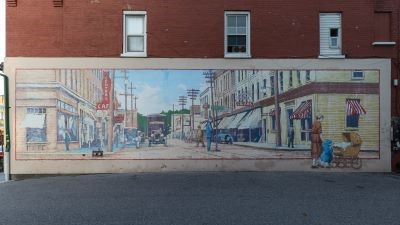 Oshawa 1935 by Dan and Peter Sawatzky Oshawa 1935 by Dan and Peter Sawatzky23 King St. W. |
Commissioned in 1995. The mural was created by father and son team Dan and Peter Sawatzky. This mural depicts Oshawa's Four Corners on Kingston Rd. (now King St. and Simcoe St) as it would have appeared in 1935. It exhibits the manually operated traffic sign, used and operated by Officer Ed Stauffer as he directed traffic during busy times. Down in the heart of Oshawa on the main street were train tracks for the Oshawa Carriage Works, which remained until 1962. |
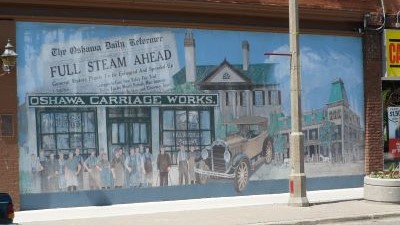 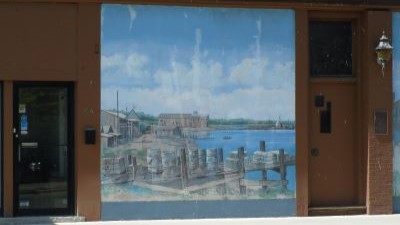 Full Steam Ahead by Gus Froese Full Steam Ahead by Gus Froese64 Simcoe St. N. |
Commissioned in 1995. The mural was created by Gus Froese. Full Steam Ahead is a collage celebrating the history of Oshawa and the Oshawa Carriage Works. Located at the back of the mural is Parkwood Estate and how it stands today. Also painted in the mural is one of Oshawa Carriage works cars, a 1924 McLaughlin Buick. On the extreme right is an original depiction of the Queen's Hotel. Established in 1874 it boasted state of the art technology with en-suite bathrooms, running water, and electricity. Painted in the centre is the Oshawa Carriage Works with their employees out front. Back behind the Oshawa Carriage Works is Oshawa's Newspaper at the time. "The Oshawa Daily Reformer" later to become the "Oshawa Times". On the far left of the mural is a depiction of the Oshawa Harbour and Barnhart's Pavilion, the local dance hall, where people went to socialize and dance. |
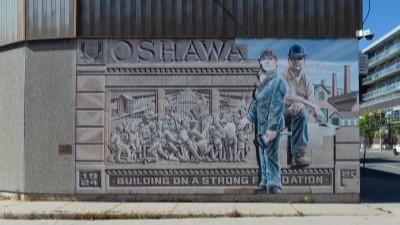 Oshawa's Development (Historical Industry and Development) by Robin Burgesse Oshawa's Development (Historical Industry and Development) by Robin Burgesse47 Bond St. W. |
Commissioned in 1996. The mural was created by Robin Burgesse. This mural portrays Oshawa's development with the slogan "Building on a Strong Foundation". Listed at the top are early companies from Oshawa's past. The panels below depict scenes from three influential companies - Warren Mills, Williams Piano Factory, and the McLaughlin Carriage Company. Many local faces are also featured. |
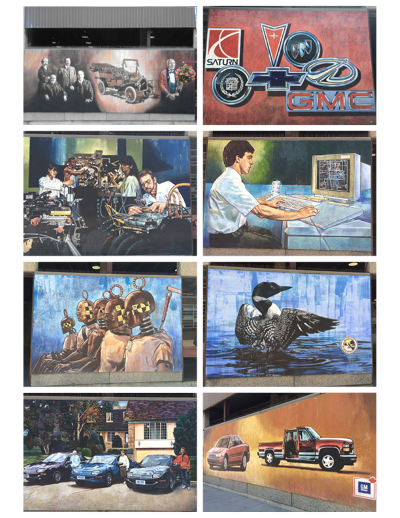 General Motors of Canada by John Hood General Motors of Canada by John Hood47 Bond St. W. |
Commissioned in 1996. The mural was created by John Hood. The first panel illustrates members of the McLaughlin Family, founders of the McLaughlin Carriage Company and McLaughlin Motor Car Company, the forerunner of General Motors of Canada. The second panel shows GM's car symbols: Buick, Saturn, Pontiac, Oldsmobile, Chevrolet, GMC, and Cadillac. The diversity of the work force is illustrated on the third panel through the use of gender, race and age. Through the instillation of technology, car designs change as shown on the fourth panel. The Crash Test Dummies found at the GM South Plant are painted on to the fifth panel. The loon found on the sixth panel is seen at either the GM Canada Headquarters, at the McLaughlin Bay, or the Second Marsh project. The inspiration for the next portion of the mural came from an actual letter and enclosed photograph. It shows three generations: a grandmother, a mother, and a granddaughter, standing proudly in front of their new "Sunfires." They wrote GM expressing how pleased they were with their new cars. In the final panel painted are two examples of the cars produced in Oshawa: the Buick Century and the GMC Pick-up. |
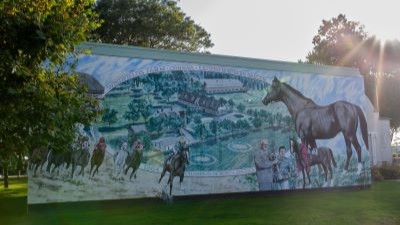 Windfields Farm by David Yeatman Windfields Farm by David YeatmanMcLaughlin Band, Shell Memorial Park 110 Simcoe St. S. |
Commissioned in 1996. The mural was created by David Yeatman. Windfields Farm was the home of champion racehorse Northern Dancer. Both the 1964 Kentucky Derby and Queen's Plate winner, Northern Dancer is pictured after his historic Kentucky Derby win with jockey Bill Hartack and EP Taylor, owner of Windfields Farm. Windfields Farm became one of the most renowned thoroughbred stables in North America. |
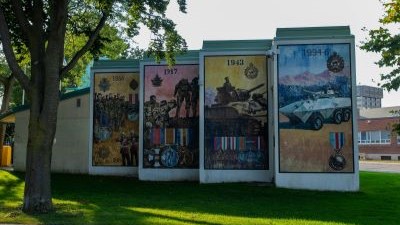 Ontario Regiment - 130 Years of Service by John Hood Ontario Regiment - 130 Years of Service by John HoodMcLaughlin Band, Shell Memorial Park 110 Simcoe St. S. |
Commissioned in 1996. The mural was created by John Hood. This mural commemorates the 130 year history of Oshawa's own Ontario Regiment and its involvement in the nation's conflicts and UN peacekeeping missions. All of the medals depicted at the bottom of the mural are accurate representations of Canadian Military decorations. |
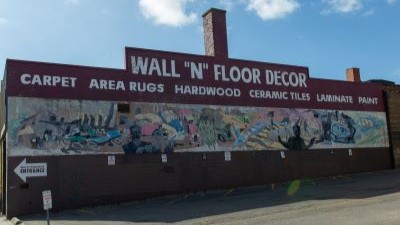 Driving Force by Rudolf Stussi Driving Force by Rudolf Stussi22 Athol St. E. |
Commissioned in 1996. The mural was created by Rudolf Stussi. The evolution of Oshawa's automobile industry is depicted in this mural. In 1899, the McLaughlin Carriage Factory was destroyed by fire, but was rebuilt within a year. The McLaughlin Motor Car Company, founded in 1907, began producing automobiles and, in 1918, became General Motors of Canada. The mural illustrates the role of General Motors during the Second World War in the manufacture of combat vehicles. The far right of the mural depicts the later technological advancements in automobile production. |
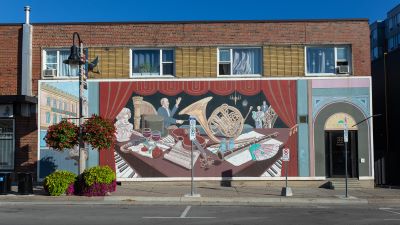 Borsberry Music Hall by Brian Romagnoli Borsberry Music Hall by Brian Romagnoli31 Celina St. |
Commissioned in 1997. The mural was created by Brian Romagnoli. This mural depicts Borsberry Music Hall, a 700 seat theatre that was located on the north side of King St., just east of Simcoe St., in the early 20th century. It played host to a number of dramatic and musical productions. The inside of the Borsberry Music Hall is portrayed as a montage on the mural. Pictured outside the Music Hall is a McLaughlin Buick from 1924. The artist decided to give the mural a little life and incorporated the doorway to the apartments into the mural painting it blue and yellow. |
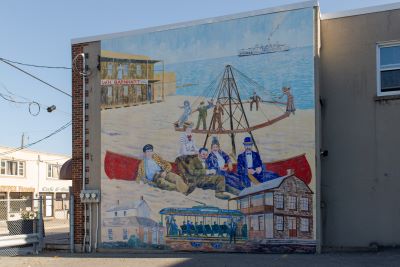 Recreation by the Lake by Tony Johnson Recreation by the Lake by Tony Johnson72-74 Celina St. |
Commissioned in 1997. The mural was created by Tony Johnson. The Lake Ontario Waterfront is pictured in this mural. It was a favourite gathering place for the Oshawa middle class. Streetcars running north and south along Simcoe St. were a popular means of getting to the waterfront. Barnhart's Pavilion (pictured in the background) was famous throughout Oshawa and beyond for its Friday night dances. Also pictured is "The Ocean Wave", a merry-go-round and prominent fixture at the lake. |
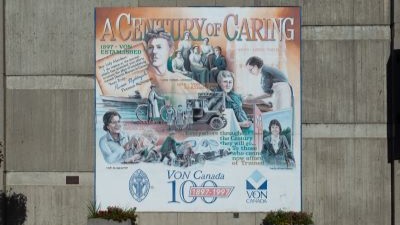 Victorian Order of Nurses - 100th Anniversary by Robin Burgesse Victorian Order of Nurses - 100th Anniversary by Robin Burgesse47 Bond St. W. (West wall of GO Bus Terminal) |
Commissioned in 1997. The mural was created by Robin Burgesse. The Victorian Order of Nurses Mural depicts the 100-year history of the VON. It was commissioned by the VON Durham branch. The VON was founded by Lady Isabel Aberdeen, the wife of the Governor General, on the request of the National Council of Women as Canada's "memorial" for Queen Victoria's 1897 Diamond Jubilee. |
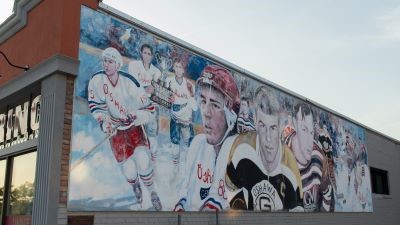 Famous Oshawa Generals by Paul Ygartua Famous Oshawa Generals by Paul Ygartua78 King St. W. |
Commissioned in 1997. The mural was created by Paul Ygartua. The Oshawa Generals Major Junior Hockey franchise was established for the 1937-38 season and immediately became a hockey powerhouse by winning seven consecutive Ontario championships through to 1944. The team has won five additional Ontario titles since then and has been the Memorial Cup champion four times, in 1939, 1940, 1944, and 1990. Featured are well-known Oshawa Generals stars of the past, including Billy Taylor, Bobby Orr, Terry O'Reilly and Eric Lindros. |
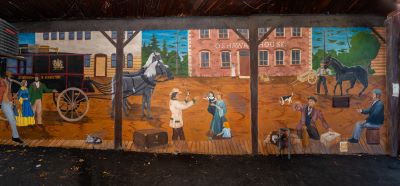 Kingston Road Stage Coach by JR Hunter, Matt Whelan, Melissa Verge, and Nicol Janecko Kingston Road Stage Coach by JR Hunter, Matt Whelan, Melissa Verge, and Nicol Janecko12 Simcoe St. S. (Carriageway) |
Commissioned in 1998. The mural was created by JR Hunter, Matt Whelan, Melissa Verge, and Nicol Janecko who were local students of O'Neill Collegiate and Vocational Institute and Monsignor Paul Dwyer Catholic High School. This mural depicts the first stage coach line that operated on Kingston Rd. (Highway 2) between Fort Frontenac (Kingston) and Fork York (Toronto), 1817 to 1855. The last stop before Fort York was at Oshawa House on the northeast corner of King and Centre St. |
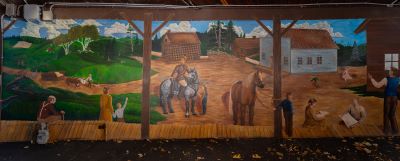 Skae's Corner by JR Hunter, Matt Whelan, Erin Hackney, Ian Mitchell and Mile Wystoski Skae's Corner by JR Hunter, Matt Whelan, Erin Hackney, Ian Mitchell and Mile Wystoski14 Simcoe St. S. (Carriageway) |
Commissioned in 1999. The mural was created by JR Hunter, Matt Whelan, Erin Hackney, Ian Mitchell and Mile Wystoski, students from students of O'Neill Collegiate and Vocational Institute and Monsignor Paul Dwyer. This mural depicts life at the four corners, 1840 to 1850. Skae's Corners became the Village of Oshawa in 1842. The first post office in Oshawa was located in the General Store owned by Skae and McDonald (the checkerboard building in the mural). The mural image looks outward from the porch at Munroe's Tavern where, in 1850, the Village of Oshawa Council held its first meeting. The other two buildings depicted are JD Hoitt's Carriage Shop and JB Warren's General Store. |
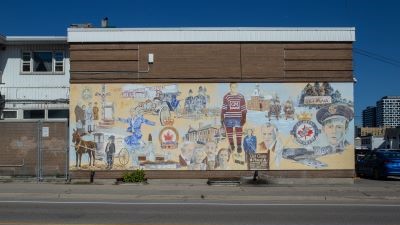 Oshawa's 75th Anniversary by Tony Johnson Oshawa's 75th Anniversary by Tony Johnson121 Simcoe St. S. |
Commissioned in 2000. The mural was created by Tony Johnson. Incorporated as a City in 1924, Oshawa celebrated its 75th anniversary in 1999. This mural is a collage of important people and places in Oshawa's history including: Donald Jackson, world famous figure skater; Lloyd Chadburn, a hero of the Second World War; Honourable Colonel Michael Starr, former Oshawa Mayor and Federal Labour minister; Robert Attersley, former Oshawa Generals hockey player; and Colonel R. S. and George McLaughlin, co-founders of General Motors of Canada, who, along with their wives, Adelaide and Annie, were patrons of Camp Samac, Memorial Park, Girl Guides, Boy Scouts, and the Canadian Automotive Museum. |
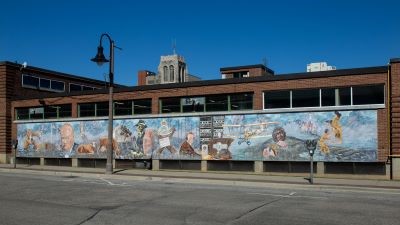 Camp X by Tony Johnson Camp X by Tony Johnson100 Simcoe St. S. (South wall of Oshawa Power Building) |
Commissioned in 2001. The mural was created by Tony Johnson. On December 6, 1941, Camp X - Special Training School 103 officially opened on the shores of Lake Ontario. Under the auspices of British Prime Minister Winston Churchill's Special Operations Executive and his Canadian Chief of Security, Sir William Stephenson, five hundred secret agent graduates were schooled in a grueling ten to twelve week curriculum that included hand-to-hand combat, interrogation techniques, psychological warfare, explosives training, as well as espionage, sabotage, and survival skills behind enemy lines. Hydra, the immensely powerful short wave radio installation at Camp X, had William "Bill" Hardcastle, among its key operators. Ian Fleming, author and creator of "James Bond", was also trained here. |
| Sculpture / Location | Details |
|---|---|
| Group Portrait 1957 by Douglas CouplandFacade of Robert McLaughlin Art Gallery 72 Queen St. Collection: Robert McLaughlin Gallery |
Group Portrait 1957 was commissioned by the RMG from artist Douglas Coupland in 2010. Inspired by the buildings minimalist architecture designed by Arthur Erickson, the sculpture is a visual reference of form and colour that honours the gallery's extensive collection of works by Painters Eleven. The RMG has the largest collection of work by this group of Canadian abstract expressionist painters who were active between 1954 and 1960. |
| Upstart II by Clement MeadmoreOutside City Hall - Civic Square Park at south end of building 50 Centre St. S. Collection: Robert McLaughlin Gallery |
Upstart II is a 25 feet tall aluminum sculpture created by Clement Meadmore in 1987 and installed at City Hall in 2012. Meadmore's work combines elements of abstract expressionism and minimalism to produce this large-scale and dramatic work of pure geometric form. |
| Oshawa Rising by Ron Baird Inside City Hall - First Floor, Main Lobby 50 Centre St. S. |
Installed in 2011, Oshawa Rising is a sculpture made of reflective stainless steel. Its intent is to reflect the movement, light and shapes of people who walk by - representing a symbol of Oshawa's past, present and future. |
| River Tree/Bench by Reinhard Reitzenstein Rear of The Robert McLaughlin Gallery 72 Queen St. Collection: Robert McLaughlin Gallery Commissioned by the Jury Committee of the RMG |
The sculpture consists of a 24 feet bronze Ironwood tree lying on its side, its position due, perhaps to high winds, or the ravage of time. River Tree/Bench's curved "spine" - the juncture from the roots has protrusions reminiscent of a backbone - and delicate root system, speak to a sublime beauty in nature that can only be truly appreciated through sympathetic understanding of what has been lost. |
| Crown by Douglas Bentham Rear of The Robert McLaughlin Gallery 72 Queen St. Collection: Robert McLaughlin Gallery |
Crown is a welded steel sculpture by Saskatchewan artist Douglas Bentham. The sculpture was first loaned to the gallery in the late 1970s and later donated in 1986. Crown is a controversial piece and has raised many discussions about the practice and creation of art. One of Canada's most prominent sculptors, Bentham's work can be found in public and private collections in Canada and the United States. With over 40 solo exhibitions and over 100 group exhibitions in public and commercial galleries, his work has gained national and international recognition. |
| Reverb by Noel Harding Tribute Communities Centre 99 Athol St. E. Collection: Robert McLaughlin Gallery Commissioned by the RMG and purchased with the financial support of the RMG Acquisition Fund and the Canada Council for the Arts Acquisition Assistance Program. |
Reverb is installed adjacent to the Tribute Communities Centre, Durham Region's premier sports and recreation facility, and the venue of the boxing and weightlifting events at the TORONTO 2015 Pan Am Games. The sculpture is impactful, standing at 19 feet high. The curved form implies a megaphone, an amphitheatre and stage, a net or goal, as Reverb reflects the activities that occur in the Tribute Communities Centre. The "blurb" shapes on the structure represent the fans and are positioned like a rake of seats. A microphone positioned above centre ice inside the Tribute Communities Centre will transmit a signal to the lights within the steel structure, transforming the sound into coloured beams of light around the sculpture that will be triggered every time the crowd inside cheers. Reverb is full of meaning and references. The laser cut stainless steel references industrial production and the facets align Oshawa's history as a port city and as an industrial capital. |
| Mushrooms by St. Stephen's Catholic Secondary School Oshawa Valley Botanical Gardens 155 Arena St. Collection: City of Oshawa |
These steel mushroom sculptures were donated by St. Stephen's Catholic Secondary School, Bowmanville, to the City of Oshawa. Between 2014 and 2015, the students of the Manufacturing class designed and fabricated the sculptures. The school has also donated sculptures to locations such as The Toronto Zoo, Harris Steel (Windsor), Gerdau Steel, Whitby, and the Town of Essex. |
| Grace by Mary Anne Barkhouse Front lawn of The Robert McLaughlin Gallery 72 Queen St. Collection: Robert McLaughlin Gallery |
Commissioned in 2007, Grace by Mary Anne Barkhouse is a modern interpretation of the Three Graces by Antonio Canova, representing three beavers as the goddesses of Beauty, Mirth and Good Cheer resting on a slab of Canadian Shield granite. Working with animal imagery in a variety of mediums, Barkhouse is best known for her examination of Indigenous culture and environmental sustainability. |


